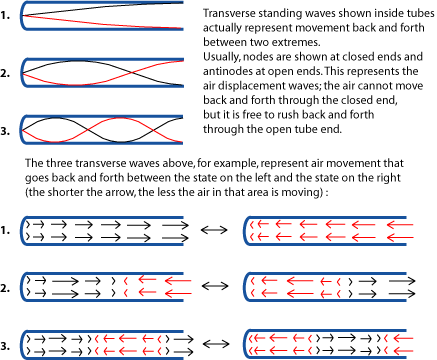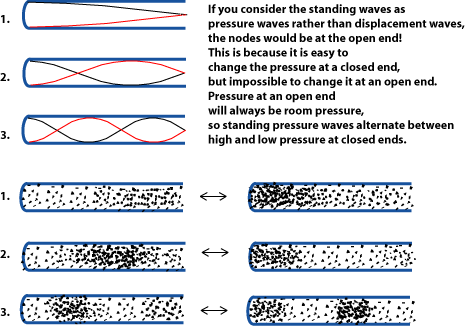| << Chapter < Page | Chapter >> Page > |

The standing waves in a wind instrument are a little different from a vibrating string. The wave on a string is a transverse wave , moving the string back and forth, rather than moving up and down along the string. But the wave inside a tube, since it is a sound wave already, is a longitudinal wave ; the waves do not go from side to side in the tube. Instead, they form along the length of the tube.

The harmonics of wind instruments are also a little more complicated, since there are two basic shapes ( cylindrical and conical ) that are useful for wind instruments, and they have different properties. The standing-wave tube of a wind instrument also may be open at both ends, or it may be closed at one end (for a mouthpiece, for example), and this also affects the instrument. Please see Standing Waves in Wind Instruments if you want more information on that subject. For the purposes of understanding music theory, however, the important thing about standing waves in winds is this: the harmonic series they produce is essentially the same as the harmonic series on a string. In other words, the second harmonic is still half the length of the fundamental, the third harmonic is one third the length, and so on. (Actually, for reasons explained in Standing Waves in Wind Instruments , some harmonics are "missing" in some wind instruments, but this mainly affects the timbre and some aspects of playing the instrument. It does not affect the basic relationships in the harmonic series.)
So far we have looked at two of the four main groups of musical instruments: chordophones and aerophones. That leaves membranophones and idiophones . Membranophones are instruments in which the sound is produced by making a membrane vibrate; drums are the most familiar example. Most drums do not produce tones; they produce rhythmic "noise" (bursts of irregular waves). Some drums do have pitch , due to complex-patterned standing waves on the membrane that are reinforced in the space inside the drum. This works a little bit like the waves in tubes, above, but the waves produced on membranes, though very interesting, are too complex to be discussed here.
Idiophones are instruments in which the body of the instrument itself, or a part of it, produces the original vibration. Some of these instruments (cymbals, for example) produce simple noise-like sounds when struck. But in some, the shape of the instrument - usually a tube, block, circle, or bell shape - allows the instrument to ring with a standing-wave vibration when you strike it. The standing waves in these carefully-shaped-and-sized idiophones - for example, the blocks on a xylophone - produce pitched tones, but again, the patterns of standing waves in these instruments are a little too complicated for this discussion. If a percussion instrument does produce pitched sounds, however, the reason, again, is that it is mainly producing harmonic-series overtones .
Some idiophones, like gongs, ring at many different pitches when they are struck. Like most drums, they don't have a particular pitch, but make more of a "noise"-type sound. Other idiophones, though, like xylophones, are designed to ring at more particular frequencies. Can you think of some other percussion instruments that get particular pitches? (Some can get enough different pitches to play a tune.)

Notification Switch
Would you like to follow the 'Sound, physics and music' conversation and receive update notifications?